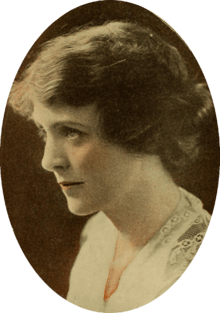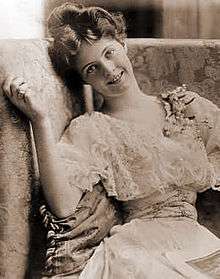Mabel Taliaferro
| Mabel Taliaferro | |
|---|---|
 | |
| Born |
Maybelle Evelyn Taliaferro May 21, 1887 Manhattan, New York City, U.S. |
| Died |
January 24, 1979 (aged 91) Honolulu, Hawaii, U.S. |
| Other names | Nell |
| Occupation | Actress |
| Years active | 1899–1956 |
| Spouse(s) | |
| Children | Bill Taliaferro (b. 1924)[3] |


Mabel "Nell" Taliaferro (May 21, 1887 – January 24, 1979) was an American stage and silent-screen actress, known as the Sweetheart of American Movies.[4]
Biography
She was born as Maybelle Evelyn Taliaferro in Manhattan, New York City and raised in Richmond, Virginia. Taliaferro was descended on her father's side from one of the early families who settled in Virginia in the 17th century, the Taliaferros, whose roots are from a northern Italian immigrant to England in the 16th century.
Mabel Taliaferro began her stage-career with Chauncey Olcott. Later she appeared with James A. Hearne and with Sol Smith Russell in "A Poor Relation." In 1899, she achieved distinction in the role of little Esther in Israel Zangwill’s play, "Children of the Ghetto." A year later she played the witching elf-child in Yeat’s Gaelic fantasy, "The Land of Heart’s Desire." In 1902-3 Mabel Taliaferro appeared in "An American Invasion" with John E. Dodson and Miss Annie Irish. The following year she was seen in the support of Louis Mann in "The Consul." Her greatest opportunity came when she was cast for Lovey Mary in "Mrs. Wiggs of the Cabbage Patch," a part she played continuously for two and one-half years. In 1905 she supported Arnold Daly in "You Never Can Tell" and later went on tour in "The Bishop’s Carriage." After a brief season in vaudeville she joined William Collier’s company in a tour of Australia. In 1906 Mabel Taliaferro married (as her first husband) Frederick Thompson, creator of the Luna Park on Coney Island and the New York Hippodrome, under whose management she starred in "Polly of the Circus".[5][6]
In 1907 she was injured in a car crash.[7] In 1912 her movie career began with the Selig Studios film version of Cinderella co-starring her then-husband Thomas Carrigan.[8] She continued performing in films through her retirement in 1921. In 1940, she appeared in her final picture, My Love Came Back. Taliaferro was a sister of film and stage actress Edith Taliaferro and the cousin of actress Bessie Barriscale.[9][10]
She died on January 24, 1979.[4]
Filmography
- My Love Came Back (1940)
- Alexander Hamilton (1924)
- The Rich Slave (1921)
- Sentimental Tommy (1921)
- The Mite of Love (1919)
- Draft 258 (1917)
- Peggy Leads the Way (1917)(extant)
- The Jury of Fate (1917)
- Peggy, the Will O' the Wisp (1917)
- A Magdalene of the Hills (1917)
- The Barricade (1917)
- A Wife by Proxy (1917)(*extant)
- The Sunbeam (1916)
- The Dawn of Love (1916)
- God's Half Acre (1916)(*extant)
- The Snowbird (1916)(*extant )
- Her Great Price (1916)
- The Three of Us (1914)
- The Sunbeam (1912)
- Cinderella (1911; released January 1, 1912)
Stageplay
- Springtime Folly (1951)
- Bloomer Girl (1946)
- Victory Belles (1944)
- George Washington Slept Here (1941)
- Back Fire (1932)
- The Piper (1920)
- Luck in Pawn (1919)
- Young Wisdom (1914)
- The Call of the Cricket (1910)
- Springtime (1909)
- Polly of the Circus (1908)
- Pippa Passes (1906)
- You Never Can Tell (1905)
- Mrs. Wiggs of the Cabbage Patch (1905)
- The Land of Heart's Desire (1903)
- The Consul (1903)
- The Little Princess (1903)
- An American Invasion (1902)
- The Price of Peace (1901)
- Lost River (1900)
- Children of the Ghetto (1899)
TV
- The De Santre Story (1956)
- The Hat from Hangtown (1952)
- Mistress Sims Inherits (1949)
- You Can't Take It with You (1945)
References
- ↑ New York Times Mabel Taliaferro A Bride. Actress Married to Tom Carrigan, Her Leading Man. Thursday July 10, 1913
- ↑ New York Times Actress's Baby Wanders. Mabel Taliaferro's Child is Found in a Wood ... Thursday January 6, 1921
- ↑ https://news.google.com/newspapers?nid=1499&dat=19480326&id=tzAaAAAAIBAJ&sjid=ICUEAAAAIBAJ&pg=3382,5058927&hl=en
- 1 2 "Mabel Taliaferro, 91, Star of Silent Screen Acted in 100 Plays". New York Times. February 3, 1979.
- ↑ "Fred Thompson Marries. Head of Thompson & Dundy Weds Miss Mabel Taliaferro". New York Times. December 1, 1906.
- ↑ "Mabel Taliaferro Sues. Charges Her Husband, Fred Thompson, with Cruelty in Divorce Action". New York Times.
- ↑ "Mabel Taliaferro Hurt In Car Crash. Badly Cut on Arm and Bruised When Brougham is Wrecked on Broadway". New York Times. December 27, 1907.
- ↑ Pictorial History of the Silent Screen by Daniel Blum c. 1953 page 25
- ↑ New York Times . Saturday December 1, 1906
- ↑ New York Times
External links
| Wikimedia Commons has media related to Mabel Taliaferro. |
- Mabel Taliaferro on IMDb
- Mabel Taliaferro at the Internet Broadway Database
- Mabel Taliaferro portrait gallery of Mabel Taliaferro NY Public Library
- portrait of Mabel Taliaferro 1910s (moviecard)